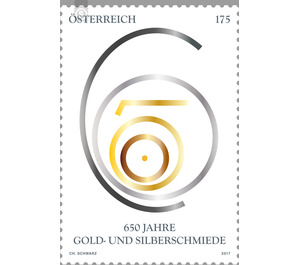650 years - Austria / II. Republic of Austria 2017 - 175 Euro Cent
Theme: History & Politics
| Country | Austria / II. Republic of Austria |
| Issue Date | 2017 |
| Face Value | 175.00 |
| Edition Issued | 150,000 |
| Perforation | 13¼ x 14 |
| Printing Type | Offset / metal foil hot stamping |
| Stamp Type | Commemorative |
| Item Type | Stamp |
| Chronological Issue Number | 2672 |
| Chronological Chapter | OOS-OE2 |
| SID | 627024 |
| Dimensions | 50.00 x 34.00 |
| In 71 Wishlists | |
In 1366 the first goldsmith's manual was issued, thus founding the guild of goldsmiths and silversmiths. A year later, the Zechordnung. On 15 December 1367 was written down in the "Zechordnung", under what provisions the goldsmiths in Vienna had to exercise their profession. With their 42 points, the rules created by the masters in their own sphere of influence go far beyond the ducal certificate. In the period before, goldsmiths and silversmiths used to live in monasteries, where they performed their artistic and brilliant work for the church and the court. Only gradually did craftsmen settle in the cities, and with that came the need to organize the various trades. Craftsmen of the same trade joined together in the city to guilds and brotherhoods. The guild of goldsmiths was on 13 October 1366 by the craft order of the prince Albrecht III. and Leopold III. legally recognized by Habsburg. The two Habsburg dukes were brothers of Duke Rudolf IV, the founder of the University of Vienna, who is also known as "the founder". The goldsmiths enjoyed a special reputation for their artful works and noble material. In the year 1367 the goldsmiths and brotherhoods regulated the internal organization with a Zechordnung. The guild was closed, the membership hereditary and an entry only possible through marriage. Over time, the guild scheme has been changed and adapted again and again. In 1859 the industrial code divided the industries into free trade, free trade with registration and licensed trade with a compulsory certificate of competence. To the latter belongs the goldsmith's craft. Today this is referred to as a regulated trade: for the exercise of the apprenticeship and the master craftsman certificate are required. The stamp shows the logo of the jubilee year: the stylized number 650 with a shiny metal foil. The golden circle and the dot in the middle symbolize the gold and the sun and thus the heat, which is essential for gold processing. The silver semicircle stands for the sickle of the moon and for the silver.


